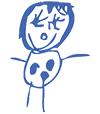EECERA Conference 2025 – Guest Blog # 30: Screen Hugs and Shared Songs
Posted 22nd August 2025
One of a series of short blog posts by presenters who will be sharing their work at the upcoming annual conference in Bratislava, Slovakia. Any views expressed in this post are those of the author(s) and do not necessarily reflect the official stance of their affiliated institution or EECERA.
Screen Hugs and Shared Songs: How the Mosaic Approach Helps Children’s Voices Travel 5,000 Miles
By Dr. Jie Gao, UCL Institute of Education, Prof. Rachael Levy, UCL Institute of Education, Prof. Minyi Li, Beijing Normal University

Photo by Redicul Pict on Unsplash
Picture this: a group of four-year-olds in London singing a cheerful “Hello” song into a camera. Thousands of miles away in Beijing, children responded with a warm “你好” (hello in Mandarin) waving excitedly before one child leaned forward to hug the computer screen. In that moment, two classrooms separated by language, time zones, and cultural traditions were united by simple but powerful gestures of connection.
These exchanges remind us that young children are not only capable of expressing themselves in “one hundred languages”, but also of building bridges across cultures in ways adults rarely imagine possible.
Moments like these sat at the heart of our research project “Adapting the Mosaic Approach in Culturally Diverse Early Childhood Settings”, where we worked with two preschools serving disadvantaged communities, one in South London and one in suburban Beijing. Adopting the Mosaic Approach (Clark & Moss, 2001) which integrates a variety of participatory activities to build a “mosaic” of children’s perspectives, children and teachers in our study took initiatives and co-created diverse ways of sharing “a day in preschool” with their peers overseas.
What we discovered was far more than playful exchanges of songs, drawings and crafted artefacts. The cultural-exchange process opened up profound reflections for researchers, teachers and children. In England, teachers saw shy children step forward with confidence when given creative ways to communicate. In China, teachers reflected on shifting from being “authorities” to genuine “listeners”, a transformation encouraged by the recent educational policies, but also sometimes in tension with their cultural and institutional norms.
This is the nuance of applying the Mosaic Approach across cultures. It is never just about tools or techniques. Instead, it is about relationships, power, and the willingness and courage to let children and teachers shape the process together. Our study showed that when adapted with sensitivity, time, trust, and reflection, the Mosaic Approach can empower children to connect across borders and enable teachers to reimagine what listening to young children really means in practice.
The Mosaic Approach in Action
In our study, children chose their own ways of expression to “share my day in preschool” with their peers 5000 miles away, ranging from drawings and collages to Lego models and playdough creations. What began as simple sharing soon evolved into something more powerful. The children themselves suggested a live online meeting. Initially, all the researchers and teachers were worried about language barriers and sceptical of practicality. But the children’s enthusiasm carried the idea forward. The result exceeded every expectation. The meeting was filled with songs, dances, sharing of creations, and spontaneous gestures of friendship from screen hugs to hand-formed heart signs. The children needed no shared spoken language to communicate, they built their own forms of connection.
Teachers, too, became active co-researchers. They kept reflective journals and participated in an online conference to discuss their reflections. The knowledge exchange between teachers, as well as with researchers, was transformative for all.
Strengths and Challenges
One of the key strengths of the Mosaic Approach, as our findings substantiate, is its flexibility and openness to cultural adaptation. It gave children meaningful ways to express themselves, while also prompting teachers to reconsider their everyday practices. The “blank” piece in the mosaic, which is a space for creativity and responsiveness, proved invaluable in enabling children to lead, surprise, and teach adults new ways of thinking.
However, our study also highlighted challenges. In China, tensions arose between the Mosaic Approach’s philosophical ethos and the traditionally hierarchical teacher–child relationship shaped by Confucian values. Our Chinese teachers noted that while policy reforms now encourage “listening pedagogies”, implementing such approaches requires sensitivity, institutional support, and professional development.
Ethical issues also surfaced, such as how to obtain parental consent in culturally-appropriate ways. Moreover, both English and Chinese teachers pointed to the time and workload pressures of integrating “slow” research into busy school routines.
These complexities highlight that participatory approaches cannot simply be “transplanted” from one cultural context to another. They must be carefully adapted, negotiated, and rooted in local practices, values, and relationships of trust. What excites us most about participatory research is its potential to transform relationships. It also reminds us that listening is not enough. Children’s contributions must be acted upon to shape practice and policy in tangible ways.
This project is part of our wider professional commitment to participatory methodologies in early childhood education. We welcome collaboration and dialogue with fellow researchers, practitioners, parents and policymakers who share a commit to listening to children’s voices in education.
Dr. Jie Gao and Prof. Minyi Li, will present work referred to in this blog in Symposium Set A14 | Tuesday 26th August 2025. (Schedule liable to change; please refer to final programme for details).
